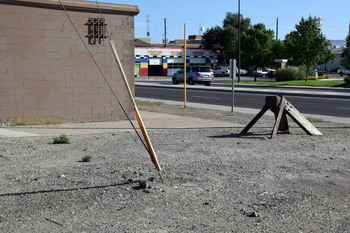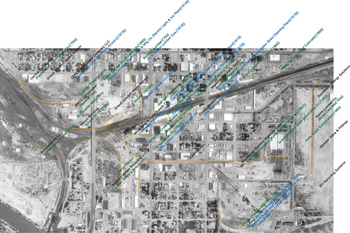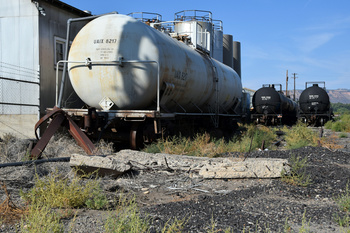Grand Junction Industry Trackage – part 1 [Trackside Colorado PA]
 : end of the lead at S 5th St
: end of the lead at S 5th StThese are the Rio Grande original facilities remained along its route in Colorado; industry trackage at Grand Junction.
The Rio Grande only defined the term "siding" in its Rules and Regulations of the Operating Department[1]. But the railroad also used the terms "spur", "industry trackage", and "lead" in its Special Time-Table Rules: the term "spur" was designated to relatively long particular industry trackage like Rocky Spur at MP18.0 or C. V. Spur at MP615.8 between Wellington and Price[2].
In this way, the proper use of these terms remained uncertain for me. Accordingly, I chose the term "industry trackage" for the title of this post because of its broad sense.
Anyhow, the Rio Grande at Grand Junction had quite a number of customers served by way of siding, spur, industry trackage, or lead.
As of Dec. 4, 2018, Trains News Wire, the introducing of Precision Scheduled Railroading at Union Pacific will be implemented by the middle of 2019. It is already announced that tri-weekly MNYRO/MRONY between Denver and Salt Lake City was switched to tri-weekly MNYGJ/MGJNY between Denver and Grand Junction since Dec. 2018. These may bring some changes to the local traffic at Grand Junction and its vicinity. Here, I represent the documents of the local traffic at Grand Junction and its vicinity as of summer 2017 as a reminder.
 : historical industrial trackage and industries
: historical industrial trackage and industriesIn the brochure "SITE-SEEING TOUR OF Rio Grande COLORADO-UTAH BUSINESS BELT" printed by the railroad in the mid-'60s, the variety of industry in Grand Junction is introduced as "gilsonite plant produces gasoline, coke, diesel fuel and gilsonite, and there are two large uranium and vanadium ore processing plants. Electronic manufacturing, along with precision instruments and missile parts plants, are typical examples of recent additions to the Grand Junction industry. Peaches, pears, and row crops are grown in the warm, fertile, irrigated Grand Valley". And various sizes of industrial sites are claimed available at Rio Grande East Yard property.
According to the Utah Industry Maps of the ’60s at the UtahRails.net web page, there was industry trackage at both east and west of the depot, diverting both north and south from the main and siding. Six of them survive, five of them are still active today.
1973 USGS aerial photo above shows Grand Junction industrial area east of the depot. Surviving industry trackage is shown in yellow line, while yellow dots show abandoned ones. Identified rail-served industry names at 1919 Sanborn Fire Insurance Maps are represented in blue, names at D&RGW Industry Map of the ’60s are represented in green, and recent names such as at City of Grand Junction GIS Business Map are represented in black.
All photos are taken on Sep. 11, 2017
revised, Oct. 28, 2019
[1] 1965 Rules and Regulations of the Operating Department, Denver & Rio Grande Western Railroad Company;
[2] 1974 System Time-Table No. 2, Denver & Rio Grande Western Railroad Company;
* 1919 Sanborn Fire Insurance Maps;
* D&RGW Utah Industry Map of the ’60s;
* City of Grand Junction GIS Business Map;
 : end of the lead at GMCO Corp.
: end of the lead at GMCO Corp.旧D&RGW沿線に今も遺るRio Grandeの遺物を紹介している。
かつては毛細血管のように町中に張り巡らされていた引き込み線も、こんにちでは洋の東西を問わず、見かけることは少なくなってきた。旧D&RGW本線の中間地点にあたるコロラド州Grand Junctionの町もその例外ではないが、それでもまだ幾カ所か生き残っている。しかし、路線を引き継いだUnion Pacificにおいても、Precision Scheduled Railroading(ハンター・ハリソン氏が提唱した鉄道の高効率運行・経営手法)の導入を拡充すると昨年末のTrains News Wireで報じられていた。鉄道会社にとって効率の悪いサービスの存続は今後望めない。したがって、これら引き込み線の存続も予断を許さない。そこで、一昨年訪ねた際の様子を記録としてここで順次紹介する。
下のモノクロ航空写真は1973年撮影のGrand Junction中心部。黄色実線が2019年現在まだ遺っている引き込み線、破線は撤去済みの引き込み線である。沿線の企業名は青が1919年現在、緑が1960年代、黒が現在のもの。それぞれSanborn Fire Insurance Map、D&RGW Industry Map、City of Grand Junction GIS Business Mapがその原典である。
2019-02-22 09:00
コメント(0)




コメント 0